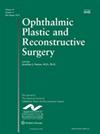Orbital Myeloma and Plasmacytoma: An Australian Study.
IF 1.2
4区 医学
Q3 OPHTHALMOLOGY
Ophthalmic Plastic and Reconstructive Surgery
Pub Date : 2024-09-10
DOI:10.1097/iop.0000000000002777
引用次数: 0
Abstract
PURPOSE The purpose of this study was to provide Australian data on the clinical and radiological features and outcomes in patients with orbital plasmacytomas. METHODS Multicentre retrospective review of orbital plasmacytoma and orbital involvement in multiple myeloma (MM) from 2005 to 2022 in Australia. RESULTS Twenty-one participants were identified. The median age was 62 years (range 34-88 years), and 11 (52%) were females. Eighteen (84%) had a known diagnosis of MM prior to their orbital presentation, with all patients eventually being diagnosed with systemic MM. Thirteen (72%) were receiving active treatment for systemic myeloma on presentation, while 3 (17%) were in remission. All but 1 had unilateral orbital involvement (n = 20, 95%). Common presenting symptoms and signs were decreased visual acuity (n = 13, 62%), proptosis (n = 11, 52%), limited motility (n = 15, 71%), and optic neuropathy (n = 5, 24%). Radiologically, 15 (71%) involved the superotemporal orbit, 7 (33%) inferotemporal orbit, and 16 (76%) involved ≥1 extraocular muscle. Sixteen (76%) were biopsied and confirmed orbital plasmacytoma on histopathology. Treatment modalities included intravenous and oral steroids (n = 7, 33%), chemotherapy (n = 9, 43%), radiotherapy (n = 13, 62%), stem cell transplant (n = 3, 14%), and surgical debulking and decompression (n = 3, 14%). Mortality was high, with 15 (71%) having MM-related mortality. CONCLUSIONS This is the largest cohort of Australian data on orbital plasmacytomas. Most patients have a diagnosis of systemic MM at presentation. It is crucial to recognize and treat these patients early due to a poor systemic prognosis.眼眶骨髓瘤和浆细胞瘤:一项澳大利亚研究。
目的本研究旨在提供澳大利亚眼眶浆细胞瘤患者的临床和放射学特征及预后数据。方法2005年至2022年澳大利亚多中心回顾性研究眼眶浆细胞瘤和多发性骨髓瘤(MM)眼眶受累的情况。中位年龄为62岁(34-88岁),女性11人(52%)。18人(84%)在眼眶发病前已确诊为MM,所有患者最终都被诊断为全身性MM。13例(72%)患者在发病时正在接受系统性骨髓瘤的积极治疗,3例(17%)处于缓解期。除一名患者外,其余患者均为单侧眼眶受累(n = 20,95%)。常见的症状和体征为视力下降(13例,62%)、突眼(11例,52%)、活动受限(15例,71%)和视神经病变(5例,24%)。从放射学角度看,15 例(71%)累及颞上眶,7 例(33%)累及颞下眶,16 例(76%)累及≥1 块眼外肌。16例(76%)患者进行了活组织检查,组织病理学证实为眶浆细胞瘤。治疗方法包括静脉注射和口服类固醇(7例,33%)、化疗(9例,43%)、放疗(13例,62%)、干细胞移植(3例,14%)以及手术切除和减压(3例,14%)。死亡率很高,其中15人(71%)的死亡率与MM有关。大多数患者在发病时被诊断为全身性 MM。由于全身性预后较差,因此早期识别和治疗这些患者至关重要。
本文章由计算机程序翻译,如有差异,请以英文原文为准。
求助全文
约1分钟内获得全文
求助全文
来源期刊
CiteScore
2.50
自引率
10.00%
发文量
322
审稿时长
3-8 weeks
期刊介绍:
Ophthalmic Plastic and Reconstructive Surgery features original articles and reviews on topics such as ptosis, eyelid reconstruction, orbital diagnosis and surgery, lacrimal problems, and eyelid malposition. Update reports on diagnostic techniques, surgical equipment and instrumentation, and medical therapies are included, as well as detailed analyses of recent research findings and their clinical applications.

 求助内容:
求助内容: 应助结果提醒方式:
应助结果提醒方式:


